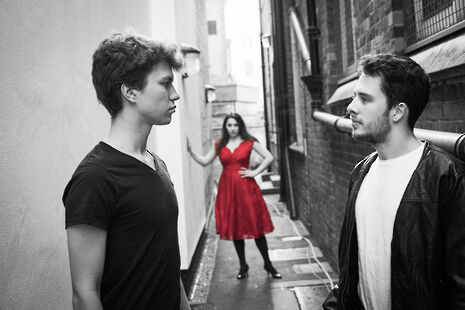Review: West Side Story
This production presents a traditional and vibrant rendition of a stage and film classic

Bringing a classic to Cambridge, this production of West Side Story trumps the 1961 Wise and Robbins film adaptation, bringing energetic choreography and rivalling vocals, but lacks the polish and authenticity needed to go all the way. West Side Story retells Shakespeare’s Romeo and Juliet in 1950s America, where race, class, and gang warfare clash with the teenage world of love, lust, and ambition.
As the curtain rises to reveal one of the best set designs I’ve seen on the Cambridge theatre scene, thanks to its realistic details, the audience is welcomed to the performance by the signature powerful rhythms of the musical. Throughout the show, the live band plays brilliantly, adding a depth to the acting and singing that is only achievable through such a medium. The lighting also aids the on-stage action, as the contrasts between shadowy, filtered light in the darker scenes, and luminous spotlights of radiance in the romantic scenes starkly compare to create a balanced atmosphere for this gritty urban drama.
But, naturally, the real star of the show is the singing, which from the whole cast was of high standard. Favourites such as ‘America’, ‘Cool’ and ‘I Feel Pretty’ were performed astoundingly well considering the impressively intense choreography that worked with the music. The scenes in which there were only one group on stage at a time seemed to work best: Anita and her girls, the Jets, and Maria and her friends in these cases, providing an intimacy and palpable chemistry between the actors. Individuals who shone included Megan Gilbert’s Anita, whose vocals and acting never compromised each other; Tom Beaven as Riff, bringing the most genuine characteristics and best male choreography; and Stanley Thomas as A-Rab, who brought individualisation and comedy to a member of an otherwise indistinguishable gang of rowdy boys. However, the Sharks lacked the charisma and suave-quality an audience may be used to from the story, with accent and style issues blocking a genuine portrayal. But the leads make up for this: Laura Makhoul and Joe Beighton, Maria and Tony, although acting a slightly naff and implausible love plot that wasn’t given enough time to blossom believably, blew the audience away with their solos and duets.
Indeed, the love story could have done with some modernisation as well. One can’t help but feel but a different interpretation of Tony may have helped in this stance. Richard Beymer - Tony in the film version - famously lamented the schmaltziness of Tony’s character and longed to play him as a ‘real’ Jet – an idea this production may have benefited from. Nevertheless, the other plot devices were enough to make up for this conventional retelling. The friction between police and kids was nicely crafted in the ‘Gee, Officer Krupke’ scene, which had the audience in stitches. The interesting take on the star-crossed lovers element, and its thematic connection with fate– the cast move as one omnipotent being, re-enacting the climactic scene of the deaths of Riff and Bernardo, forcing the scene to the same end by their presence – also brings a new, more explicitly Shakespearean nod to the production. The initial rumble scene itself, arguably the pivotal moment of the musical, maintained a tense tone which quickly crumbled to a scene of emotional chaos as bodies began to litter the stage.
Ultimately, this production is traditional in its nature – capturing the music, the dance, and the drama which made the musical so popular in the first place. Whilst it at times lacks creative spark, its talented cast redeems the conventionalities with their enthusiasm and vibrancy, bringing this classic rumbling back to life again.
 Interviews / You don’t need to peak at Cambridge, says Robin Harding31 December 2025
Interviews / You don’t need to peak at Cambridge, says Robin Harding31 December 2025 News / Unions protest handling of redundancies at Epidemiology Unit30 December 2025
News / Unions protest handling of redundancies at Epidemiology Unit30 December 2025 Comment / What happened to men at Cambridge?31 December 2025
Comment / What happened to men at Cambridge?31 December 2025 Features / ‘Treated like we’re incompetent’: ents officers on college micromanagement30 December 2025
Features / ‘Treated like we’re incompetent’: ents officers on college micromanagement30 December 2025 Theatre / We should be filming ADC productions31 December 2025
Theatre / We should be filming ADC productions31 December 2025








